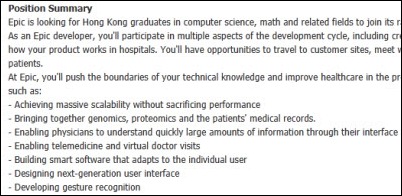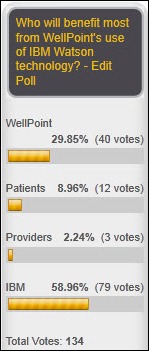"A valid concern..." Oh please. Everyone picks the software they like and the origin of that software is an afterthought.…
Monday Morning Update 9/26/11
From My Little Pony: “Re: Epic. They’re recruiting programmers from Hong Kong.” The job posting says Epic is looking for Hong Kong software developers, with paid relocation to Verona. Epic will have a recruiting team in Hong Kong in November. I found the list of solutions the noobs might be working on interesting: genomics and proteomics, telemedicine, creating software that adapts to the individual user, developing next-generation user interfaces, and adding gesture recognition. Epic always resists the idea of outsiders setting usability standards that vendors would be required to follow, but it sounds as though the company has something potentially big in the works. Another version of the same ad is aimed at developers from Singapore.
From Gluteus Max: “Re: Epic being perceived as ACO ready. Epic is good at storing and presenting data, but it’s not good at doing useful things with it. If the ‘Epic Octopus’ business model theory is correct, that’s very much by design. Analytics and data sharing are two of the most important features ACOs will need, so it’s difficult to believe Epic is ‘close to ACO-ready.’” Unverified.
From Verona Notes: “Re: Epic. Now has 266 customers, up from 224 last year and 190 two years ago. Future vision shows Epic is listening to usability criticism, such as software that understands the physician-patient conversation and readies documentation and orders. Unsurprising stock tip: IBM servers dominate competition in internal Epic tests. Amazing logistics for so many people, but starting late=disrespect.” Unverified. There’s that usability thing cropping up again.
From Bea Fragilis: “Re: Epic. To what extent are Epic-certified people allowed to make changes to local hospital code? My sense is that those changes must be minor, documented, and controlled from Verona.” I’ve heard that Epic will let responsible customers change source code and will even provide them with programming standards and documentation to help, although they don’t encourage everybody to start hacking around. I’m interested in that answer as well, not to mention how the customer gets access to the source code (or the extent to which application behavior can be controlled through external hooks).
From MT Hammer: “Re: front-end speech recognition. A new study finds that it results in 800% more errors in patient reports compared to transcribed dictation.” The study, published in the American Journal of Roentgenology, finds that 23% of reports created with front-end speech recognition (i.e., you dictate into a microphone and your words immediately appear on the computer screen) contained at least one major error vs. only 4% of those created from standard dictation and human transcription. Overall, the error rate with speech recognition was eight times higher than with human transcription. Interestingly, speaker accents didn’t make much difference, but imaging modality was a predictor of error rates. I don’t have access to the full text of the article, so I would be interested in radiologist’s analysis (such as the significance of issues defined as errors, why the radiologist didn’t catch the mistakes on the screen when using speech recognition, etc.) Also keep in mind that this compared only two transcription options, with the third being back-end speech recognition like that of the former eScription (now Nuance), which I believe has much higher accuracy since it can consider context and history rather than just pronunciation (similar to what transcriptionists do).
From The PACS Designer: “Re: Windows 8 tour. Microsoft has revealed aspects of its new Windows 8 platform for developers to peruse. Windows 8 will be tightly integrated with a new Internet Explorer 10 using a next generation internet platform called HTML5.” The problem with pre-iPhone cell phones is that they worked like tiny, underpowered PCs with crappy keyboards. I’m not sure we need the opposite problem – PCs that work like huge iPhones – especially since touch screens are extremely rare in PC-land and the point is lost anyway since you’re either sitting in front of a desktop keyboard or a laptop. My understanding is that Win 8 will have two user interfaces, one for mobile use and one for desktop. MSFT had better make sure not to screw up the latter in trying to pander to those who yearn for an iPhone clone as their primary device.
From King Coal: “Re: HIStalkapalooza. Which night? Looking forward to it with bated breath.” Don’t count on it just yet. The potential sponsor had some venue contracting issues and won’t have enough space to handle the historically large turnout (and waitlist.) I may end up cancelling it for Las Vegas, leaving you to read your HISsies winners online instead of seeing Jonathan Bush’s one-man show crafted around them (and that I really will miss).
My Time Capsule this week from 2006: The VA Outperforms Private Hospitals in IT Vision and Resolve. An aliquot: “Like a tailor-made suit, VistA was developed to meet the VA’s needs, not those of a vendor’s ‘average’ hospital customer. Just as hospitals talked themselves into buying instead of building (helped along by vendors and risk-averse CIOs,) the industry’s darling turns out to be a homebrew job.”
Reporters and TV stations have gone crazy with their lazy, press release-sourced coverage of the prospect of turning healthcare encounters over to the Jeopardy-winning IBM Watson (most common lame headline: “The computer will see you now”) but readers here weren’t equally impressed with its announced use by WellPoint, with most saying IBM and WellPoint will get the benefit instead of patients and providers. New poll to your right: now that Sage Software has announced plans to sell its healthcare division to Vista Equity Partners, who will benefit most from that transaction?
I’ve enjoyed Vince’s HIStory series immensely, to the point that I suggested that the pre-1980 industry pioneers get together at the HIMSS conference to reminisce (and knowing some of those folks, perhaps tipple a tad). Shelly Dorenfest, Bob Pagnotta, John DiPierro, and David Pomerance are a few of those who have said they’ll be there. If you know them, you should be there, too. Drop your e-mail info on this form and Vince will be in touch. Think of it as a 30+ year class reunion of the College of HIT Hard Knocks.
This week’s e-mail from Kaiser boss George Halvorson talks up the company’s newly won Davies Award win, also mentioning that Kaiser hospitals make up 35 of the 60 HIMSS EMRAM Stage 7 hospitals and that the remaining KP hospitals are all Stage 6. And despite early reports of HealthConnect availability problems, he says KP has won six awards from the Uptime Institute, the only healthcare organization to ever win (although as a counterpoint, that’s data center uptime, and plenty of ways exist to knock users off systems even though the server is chugging along). He also mentions some employee-recommended technology projects that have been funded by KP’s internal innovation fund: an automatic glycemic calculator, a hospital capacity prediction tool, and an SMS appointment reminder system.
Weird News Andy finds this story about hospital drug shortages and the resultant third-party profiteering scary. I’ll elaborate from experience to scare him more. Even if you ignore the possibility of obtaining counterfeit or impure drugs when forced to buy from secondary channels, the patient safety risks with drug shortages are considerable. Product packaging and sometimes concentrations differ from what nurses and doctors are used to, greatly increasing the chance of wrong drug / wrong dose errors. Sometimes the backup drug is therapeutically similar but chemically inequivalent, meaning doctors are forced to use a drug that wasn’t their first choice and one they may not be all that familiar with, making it more likely that something will go wrong. Shortages come and go all the time, so information systems can’t be kept current to steer prescribers to the one currently being used, sometimes requiring IT workarounds that neuter electronic protections such as dose and allergy checking. Those drugs may have similar active ingredients that are still different enough to trigger unexpected drug allergies and drug-drug interactions. My analogy is always this: suppose you’re about to have open heart surgery, but the drugs your surgeon always uses are on shortage, meaning the surgeon will have to compromise with a less-desirable drug that they’ve rarely or never used. You’d be mad at someone for letting that situation occur. The problem here is that everyone involved claims to be innocent and powerless.
On WNA’s slightly lighter side (it involves death, so it’s still not all that light), he captions this story as “Spinal Tap’s drummer?” Coroners in Ireland review the death of a man whose body was found burned in his sitting room, with no damage to the floor on which it rested, no evidence of foul play, and no signs of the source of the flame. They conclude that he died of spontaneous combustion. A retired pathology professor ruled out divine intervention, saying, “I think if the heavens were striking in cases of spontaneous combustion, then there would be a lot more cases.”
A good article covers the high cost of children’s hospitals, with the Nemours Children’s Hospital (opening next year) in Orlando leading it off. The 95-bed hospital, being built in a city that already has two large and notable children’s hospitals, will cost $400 million ($4.2 million per bed) and was approved by the state only after the well-funded Nemours called in some political favors. Mentioned about high-profile children’s hospitals in general: lack of financial transparency, fast-rising costs accompanied by big executive paychecks and impressive construction projects, big financial war chests, and only tiny amounts of charity care provided. I can say from experience that those multi-million dollar children’s hospital CEOs have the ultimate weapon to keep the donor and political largesse flowing – feel-good happy ending stories of miraculous medical work accompanied by fuzzy-focus, intentionally heart-tugging pictures of adorable babies and toddlers. Your hospital will lose every time if your particular medical miracles involve less Hollywood-like episodic interventions on behalf of elderly patients, the chronically and incurably ill, psychiatric patients, and that particularly colorful stratum of society that shows up in the ED full of street drugs, hostile microbes, and intentionally inflicted wounds.
Don Berwick says CMS administrator is the best job he’s ever had, but he’ll lose it on December 31 unless the Senate confirms him by then. No confirmation hearings have been scheduled.
The New York Times covers telepsychiatry, where patients receive counseling sessions via Skype or specialized Web apps like Breakthrough.com. Says a psychologist, “In three years, this will take off like a rocket. Everyone will have real-time audiovisual availability. There will be a group of true believers who will think that being in a room with a client is special and you can’t replicate that by remote involvement. But a lot of people, especially younger clinicians, will feel there is no basis for thinking this.”
An OB-GYN subpoenas Bellevue Medical Center (NY), demanding a list of every person who accessed the Internet from the hospital on a particular day in 1999. The doctor is trying to find the person who posted defamatory comments about her on a physician review site, claiming she has reason to believe it came from a particular NYU doctor. The hospital says it keeps access logs for only 30 days, but the doctor’s legal team found a computer forensics expert who claims he knows a sophisticated (and undoubtedly expensive) way to bring back 12-year-old records.







“…why the radiologist didn’t catch the mistakes on the screen when using speech recognition…”
As someone intimately familiar with speech recognition editing, I can tell you the eye tends to “see” what the brain tells you SHOULD be there rather than what actually IS there. This is a well-known phenomenon among SR editors. Add to that the fact that the physicians dictating these reports using front-end SR are in a hurry to just get it over with, and it’s no surprise to see such a high error rate.
“Also keep in mind that this compared only two transcription options, with the third being back-end speech recognition…which I believe has much higher accuracy…”
You make a valid point, but the issue isn’t the comparative accuracy of front-end versus back-end SR. The comparison is between reports reviewed by a second pair of eyes versus those which are not. Whether a report is transcribed “from scratch” or edited from a SR draft, in both cases there is a skilled healthcare documentation specialist reviewing the original dictation. With front-end SR, however, it’s once-and-done, which of course is the holy grail of clinical documentation. The problem, as this study clearly shows, is that once-and-done dramatically increases the risk of medical error. Unfortunately, that risk doesn’t seem to get factored into the ROI when the front-end SR vendor is making the sales pitch.
We in the medical transcription field are doing our best to highlight the crucial risk management/clinical documentation improvement role our practitioners perform as a matter of course, a role that up to this point seems to have been taken for granted. Studies like this help prove what we’ve been saying all along: removing skilled healthcare documentation professionals from the process puts patients at risk, not to mention increasing liability for healthcare providers and jeopardizing reimbursements due to improper documentation. That’s a message we’re determined to deliver to the rest of the healthcare community as well as the public at large.
Jay Vance, CMT
National Leadership Board Director
Association for Healthcare Documentation Integrity
“Shortages come and go all the time, so information systems can’t be kept current to steer prescribers to the one currently being used, …”
My experience was the opposite: information systems played a key role in assisting providers. Some of the most straightforward CPOE decision support advisors were created by pharmacy informatics to make the provider aware of the shortage and then suggest appropriate equivalent alternatives.
Cracking the “Usability” nut is the key unleashing all the power that EMRs are purported to have. Give doctors an EMR that they want to use (one that is simple and intuitive) and they will use it. Once doctors are using an EMRs that allow detailed structured data entry efficiently, then we can mine that data to find patterns that make healthcare more efficient and decrease costs. Then we can combine outcomes data from every patient in the country as opposed to those in a few organizations (Kaiser, Aetna, etc).
Many EMRs today allow entry of very generic notes that you can send off to insurance and get reimbursed for, but tell you absolutely nothing about the patient. You can read full 3 page notes generated by these EMRs and not have a clue as to what is going on with the patient. How is that good for the patient? What do you learn from mining generic information? You put garbage into a data warehouse, you can only get garbage out.
Like your poll on Wellpoint and IBMWatson and thank goodness there are some sane folks, a few of use maybe, out here. I was equally not impressed with the media coverage. It’s all about ratings half the time and with machine learning what are they going to pour into the servers? I wrote about that myself with a big caution sign! We don’t know and 2 years ago I wrote about the government needing a Department of Algorithms or something around that line and it’s resurfacing too:)
We do have at least one professor at NYU that is trying to come to the rescue on some of the insanity with algorithmic formulas and he does a good job. Professor Seife wrote a book called “Proofness, the Dark Side of the Art of Mathematical Deception” back in 2010 and maybe he was ahead of his time. He talks about the press as he is a journalist/mathematician master and has a ton more credibility than the Quack but I agree with him and have been saying the same with studies and reports that are not relative. I have discounted the FICO analytics services they sell to where they feel a pateint’s credit status combined with other information freely available on the web will tell if a patient will take their meds, nuts and just marketing to sell some analytics.
One comparison he makes is that there was a study that said more babies live longer because we have more cars to get them to the hospital sooner when in…you get the picture and he addresses many more of the insane studies as such and even hits the Nature Journal on all their errors and so forth. He’s worth listening to for his 30 minutes with a New Zealand radio station.
He said on Twitter too this week that he’s filing suit against the NIH and will update when it’s done, again coming back to the nonsense studies and how they are both used and abused, so in medical records and all the reimbursement algorithms, i.e. Well point feeding IBMWatson. We all work with data and know what folks can be capable of if they need to make the case with math, which everyone believes the most truthful area we can find, but what if the skew the math:)
This is why some of those contests, ie. the Heritage project worry me as number one, it looks like a gamer’s site and doesn’t resemble research and #2 with a 3 million dollar carrot, who is going to go tooth and nail to defend their math, quite a few I think is possible:) Anyway in view of the WellPoint -IBMWatson arrangement the professor makes sense as we won’t know what WellPoint will be feeding Watson more than likely either.
The interview is called “numbers don’t lie but people do”-interesting.
http://ducknetweb.blogspot.com/2011/01/numbers-dont-lie-but-people-do.html
Let’s rename this site to “I love Judy.com”…Because there is no objectivity in any of these posts, if I talk someone into throwing away $160 million, you bet, I’m gonna say it’s the best thing since sliced bread……it will be fun to watch all those kool-aid drinkers when Epic’s 15 minutes run out….
Re: Windows 8,
We’re still not sure what to expect. The one genuinely innovative thing I’ve seen is that you can buy a tablet that works in every way like a tablet, and then dock that in a laptop-style docking station and use it like a docked laptop. This may (may…or may not) be the next generation of business computer–one that can be carried around and used like a tablet, but with all the power of a laptop, in the convenience of one machine. Merging your laptop and tablet together means that you can run more general-purpose programs besides email on your tablet (that’s all I see of corporate iPad usage thus far), and that means you can run more apps that are local-based and not cloud-based.
The Metro UI is nice. I have read a lot of nitpicking about it, but it’s genuinely nice.
I’m not sure if anyone is ever going to buy a Windows tablet, honestly. Not many people are buying the good Android/Chromium tablets, and I don’t see what Microsoft offers over the Google tablet platform(s). I would like Metro/Windows tablet to survive as a platform, but I’m not sure it will. You would think that Microsoft has an instant-in as far as enterprise adoption goes, but it’s getting to the point where enterprises are getting comfortable adopting Apple iPhones and iPads. So even the enterprise, where failed Microsoft consumer products thrive, may not adopt a Windows tablet as we’d expect.
The HTML5+JS API for Windows RT seems to be a VB.NET-like attempt to get a large population of (in this case) web developers to join a new platform. VB.NET was the answer for VB6 developers hesitant to adopt .NET. If HTML5+JS WinRT ends up like VB.NET, it will be a second-class citizen and will fragment the greater WinRT platform with no real benefit. Part of the reason we hear so much about HTML5+JS on Windows is that the early rumor leaks all mentioned it. In and of itself, I wouldn’t recommend building WinRT apps with HTML/JS…use C++ or .NET. And I say this as someone who would prefer to do UI in CSS/HTML4 rather than XAML (and who has done both).
Re : Epic programming changes.
Epic have whole structure here. While they do not advise you to change their actual application code you can do a number of sanctioned things;
1) Copy Epic report and make changes to your copy.
2) Use their programming point framework. Epic give you places in the workflow where custom code can be plugged in. Some may be for decision support, some are for ADT, some are for various validation functions.
Neither of these are controlled from Verona, they are maintained locally. It’s an incredibly powerful framework for those who choose to use it.
re” epic code changes”
Do that and you could easily blow ONC certification. If you are even thinking of doing that better check out self certification.
Frank,
I don’t think your statement is accurate.
If you create something that you intend to use to meet a certification requirement, then you’d have to site certify.
In addition, if you disabled something specifically relating to a certification requirement then you’d have to again replace it with another vendor module or some local development. If you chose local development, then you’d need to site certify.
Other than that, there is no prohibition to using vendor provided extension capability to do creative things.
Following up on MT Hammer’s note: “Re: front-end speech recognition…”. In 2000, as the “new” IT Director at one of the small affiliated hospitals of a big “IDN” (old term) in the DFW area, I found the contracted radiology group was using a stand-alone RIS with voice-recognition for reporting. They had a maximum 8 hour turn-around and since the physician doing the dictation watched the screen while the speech engine transcribed, any errors were corrected on the fly. Their primary motivation was the problem of keeping good transcriptionists. That solved the problem and all reports were finished by the end of every day.
That system started out using the MedSpeak engine (if I remember correctly) but later moved to Dragon and the doctors loved it. So much for error rates…
In response to bdcurn, the focus of the error study wasn’t on how quickly the reports were turned around nor on how much the doctors loved using front-end speech recognition. I have no reason to doubt what you’re saying about your experience with front-end ASR in the hospital setting. But the question still remains, how many errors got by those doctors in spite of the fact that they were supposed to be correcting mistakes on the fly? I have no doubt that if the authors of the breast imaging error study had asked the dictating physicians to estimate the error rate in their front-end ASR reports, never in a million years would they have guessed an 800% increase in errors compared to transcribed dictations.
Jay,
I don’t disagree; the results are stunning. Also, I’m not trying to encourage the demise of transcriptionists; obviously that is what you do. However, I’ve been privy to many conversations about the difficulty of keeping reliable transcriptionists; the cost of those resources not withstanding. So providers are going to continue to look for automated solutions that cut out the variability and the vendors are going to continue to address the speech recognition issues that exist in specialty areas.
My comments were to point out that having the doctors correct their own errors while dictating eliminates the possibility of “outside” errors. If they make a mistake, there was no one else to blame, so they take more responsibility for checking their work.
What our physicians found, as a side-benefit (and a big one) was that their days in AR went down significantly because there was no delay in completing the reports. I know the integration between systems has improved dramatically, so that is less of an issue than it was then, particularly with the established transcription companies, but there are still extra steps and time in the process that are eliminated by the method I described. Now that physicians have become more computer-savy, it is less of a stretch to get them to do it.
bdcurn, I do appreciate your insight, very thought-provoking points for those of us in our field to consider.